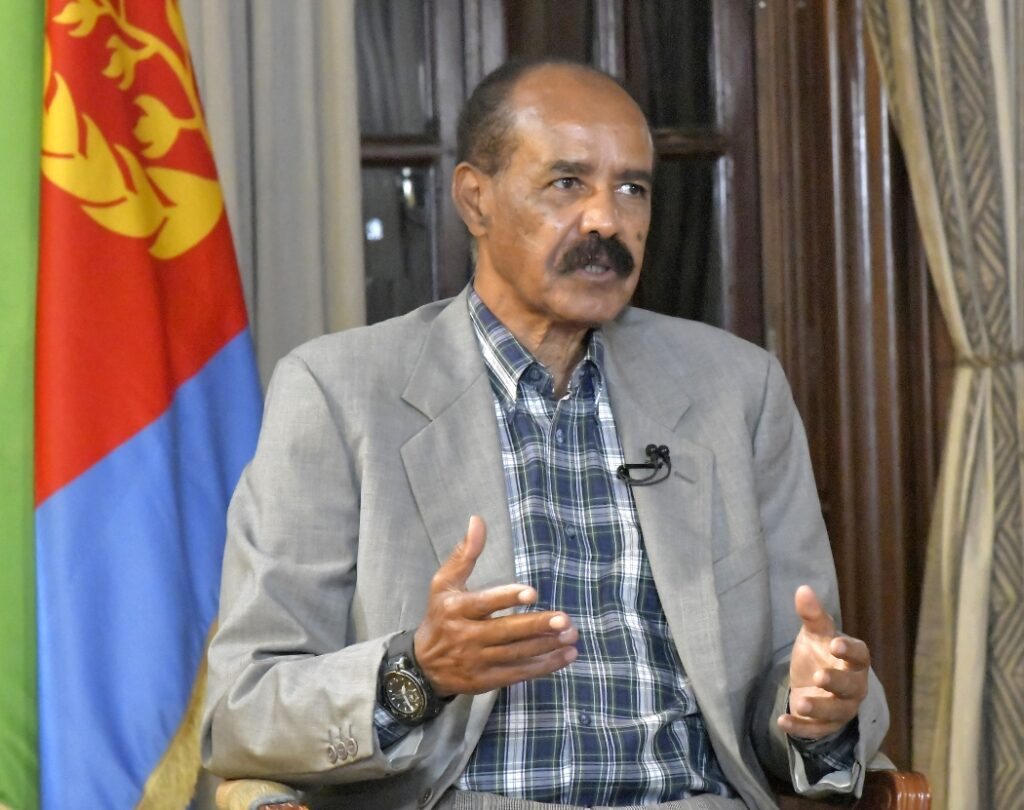Eritrean President Calls for Reevaluation of Ethiopia’s Political Framework to Foster Regional Stability

In a candid interview with local media, Eritrean President Isaias Afwerki provided a comprehensive analysis of Ethiopia’s ongoing challenges, highlighting the deep-rooted issues stemming from its constitutional framework and their implications for the region’s stability.
The discussion delved into the internal divisions within the Tigray People’s Liberation Front (TPLF), Ethiopia’s broader political struggles, and Eritrea’s perspective on the path to sustainable peace and cooperation.
The Roots of Ethiopia’s Challenges
President Isaias stressed that the recurring tensions and conflicts within Ethiopia, as well as with its neighbors, are rooted in the 1994 constitution, which he characterized as institutionalizing ethnic polarization.
“This is a recipe for perpetual tension and cannot certainly promote nation-building,” President Isaias stated. He warned that as long as Ethiopia remains divided internally, its capacity to contribute positively to regional stability, cooperation, and complementarity will be severely undermined.
The president criticized the ethnic federalism enshrined in the constitution, arguing that it fosters divisions rather than unity. According to him, this framework has not only hindered Ethiopia’s nation-building but also played a role in exacerbating external conflicts, including the Eritrea-Ethiopia border war of 1998.
Reflections on the Border War
Revisiting the border war, President Isaias described it as a consequence of Ethiopia’s misguided policies. The conflict, ostensibly triggered by a territorial dispute over Badme, was in reality a “byproduct or fallout” of Ethiopia’s internal polarization. He highlighted how external interference compounded the problem, even after the border issue was resolved through arbitration.
“The sanctity of inherited boundaries in Africa is not indeed controversial,” he asserted, pointing out that such disputes often reflect deeper political dysfunctions and vulnerabilities to external meddling.
The Current Ethiopian Landscape
Turning to recent events, President Isaias reflected on the war that followed the installation of Ethiopia’s reformist federal government. He accused the TPLF of rejecting the reform agenda and opting for armed conflict, which included launching long-range rocket attacks on Eritrea.
“Our pleas for them to refrain from unleashing this reckless war came to no avail,” he remarked.
He also commented on the post-Pretoria Agreement situation, noting the resurgence of conflict in Ethiopia’s Amhara region. Without diving into specifics, he maintained that Eritrea’s focus remains on avoiding further escalation and fostering peace in the region.
Eritrea’s Vision for Regional Stability
President Isaias reaffirmed Eritrea’s commitment to regional stability, cooperation, and complementarity, while acknowledging the complexity of the challenges. He argued that many of Ethiopia’s problems are tied to external agendas, which seek to exploit internal divisions for strategic purposes.
“Our primary preoccupation has always been to prevent and avoid costly wars,” he said, stressing that Eritrea will continue its efforts to promote peace and stability despite the difficulties.
Ethiopia’s political reform as key to regional peace and stability
The interview underscores Eritrea’s perspective on the necessity of addressing Ethiopia’s political framework as a prerequisite for peace. President Isaias’s remarks also serve as a reminder of the intricate links between domestic policies, regional relations, and external influences in shaping the Horn of Africa’s geopolitical landscape.
As Ethiopia grapples with its internal conflicts and their regional repercussions, Eritrea’s stance highlights the broader need for comprehensive reforms to achieve sustainable peace and cooperation in the region.

